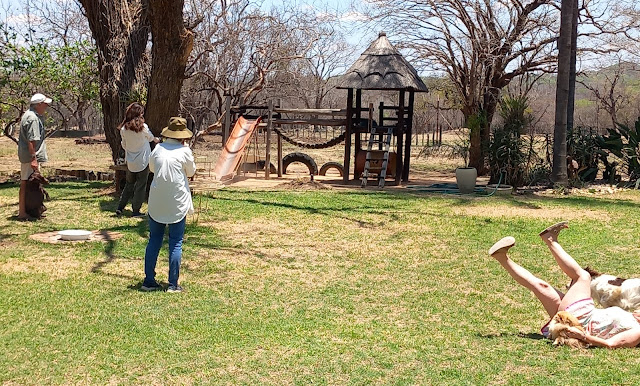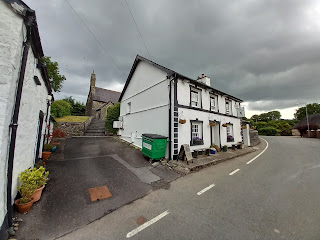 |
| Volunteer on Skomer Island |
From the enthusiastic volunteer on Skomer Island to the wetsuit-clad Australian surfer determined to place his remembrance pebble atop Dobby’s cairn on a Pembrokeshire beach, it was a lot about who we met along the way.
The Girls Trip round 2 (minus key member Vicki, so sorry!) sped out of Eastbourne at around 0900 on 12 June 2023 in Netta’s trusty Freelander packed to the gills with goodness knows what.
It successfully weaved us three to The Woodlands site at Roch in Pembrokeshire, reaching our quiet cosy mobile home Chalet Cwtch nearing sundown.
It took ages as driver Netta doesn’t do motorways, a fault Trish and I rectified upon the return journey.
 |
| Cheers Trish! We made it without chucking up |
Stepping back a few days - prior to Wales Robin and I were in Shiptonthorpe near York, celebrating Di Carter’s 90th birthday. (Thanks Susan, Ian and Vicks for the hospitality.) Trish met us there having been staying close by in Nafferton, after which we drove to Towcester, passing signs to villages with Bill Bryson-worthy names such as Styrrup and Blatherwyke, then rehydrating at The Navigation waterhole at Stoke Bruerne.
At the canal that runs past the pub we watched a man opening a lock for his narrow boat to pass through, quite an elaborate performance. Martin from Birkenhead and Ruth (steering) had set off from Chester and taken three weeks to reach this spot.
They were on their way to London to meet a whole lot of other narrow boaters to cruise together on the Thames, something to do with the St Pancreas Cruising Club of London. Ruth generously gave Trish and I a brief sail while Martin on the canal side explained the inner workings of locks to Robin.
What fun!
We met more new people – the “peanut girls” (and plenty of the usual suspects or course) at Nicky and Lez’s joint 40th birthday party in Chislehurst. It’s wonderful how these curious things called Apps can bring people together, the Peanut App being no exception.
Nolton Haven
I digress! Back to Wales – it certainly has spectacular beaches. Nolton Haven was nearest, with a vast expanse of soft sand, sea anemones hiding in rock pools and seaweed-covered rocks that glistened in the morning sun as the waves receded.

A few people with dogs and/or kids pottered about in the warm shallows, while from the towering cliffs of the Pembrokeshire coastal path you looked down upon Mediterranean-esque shades of blue water.
The next day was scorching. We aimed towards St David's Head to check out the breathtaking view but Google maps took us to St David's Cathedral instead. A good find!
Since it began as a monastery founded by St David around AD590 (being PC its C590) it has been bashed, battered, raided, earth-quaked and the present cathedral, mostly of Cambrian sandstone, is the result of centuries of rebuilding and expansion.
We learned from a mature Lincolnshire couple whose table we shared in the cool garden of St Davids Cross Hotel that St David’s is the UK's smallest city in terms of population. And that a city is a city because it has a cathedral. Cor!
The following day we visited Colin and Fuddy in Haverfordwest. They were looking well-tanned in that boiling heat and their sweet doggie Buster, brought over in the same plane that carried themselves when they fled Zimbabwe during the delightful Covid 19 lockdown, was fit, fat, flourishing and lolling drowsily on the lawn.


Pursuing puffins again
At noon on Thursday June 15 we caught the Dale Queen boat from Martin's Haven to Skomer Island, home of the Skomer Marine Nature Reserve.
Trish was particularly impressed with an 86-year-old grandmother who, with the help of her very caring and attentive grandchildren, negotiated the 87 rather steep steps that lead from the boat drop off point to the top of the island.
Mind you, David Attenborough at 96 did the same the year before.
We spent five sweltering hours there, seeking out just a sliver of shade whenever we could. Many of the island's 42,513 puffins, plus its guillemots with their gorgeous chocolate-coloured heads, razorbills, oystercatchers, seagulls and manx shearwaters were nurturing babies.
The puffins are amazing as ever, although our first trip to see them in June 2019 on Staple Island in the Farne Islands was somewhat more dramatically memorable. I think because we honestly nearly died of thirst on Skomer, just so unprepared for that heat.
The island is also home to half the world’s population of Manx shearwaters, difficult to see as they are nocturnal. In spring around 700,000 of them return from South America to breed and rear chicks. They sit on their nests in underground burrows during the day, which is when a population census can be recorded by the volunteers or staff. Manx shearwater calls are played down every burrow, and if in residence the bird will usually call back!
 |
|


 |
| Oystercatcher and chick |

Tenby
Our journey then led us to charming if touristy Tenby [I didn’t see any giant rats but read all about it in the South Wales Argus prior to arrival], where we explored the harbour and town crammed with colourful rows of triple storey houses.
While the historic Tudor Merchant's House is popular with tourists, the skinny four-storey bookstore opposite called Cofion was more captivating for the books were displayed in crazy horizontal piles. Incredibly hawk-eye Netta found a book I had been wanting - The Goshawk by T.H.White.
Dobby's fictitious bones
Next we ventured to Freshwater West to discover Dobby’s burial site – or to be precise, the place where his death scene was filmed.
After a short walk along the rocky coastline from the car park, we came across a huge mound of pebbles adorned with messages dedicated to the beloved fictional (free) house elf. Atop the pile a small cross with a flag fluttered, accompanied by a grinning toy Dobby a Harry Potter fan must have placed there.
A surfer from Victoria, Australia, wrote on and placed a pebble on the memorial mound on behalf of his family of four. He did so with reverence - and also with a little bit of a laugh.
It’s just fun and quite heart-warming to realise how connected we are, and how much the characters, books and films touch so many people from all over the world.
 |
| Freshwater West beach |
Stack Rocks
We had a little trouble finding Stack Rocks aka Elegug (Welsh for guillemot) Stacks - two isolated pillars of limestone peppered with razorbills and guillemots; as well as the Green Bridge of Wales, a dramatic natural limestone arch.
The road leading to this spectacular site on the southwest coast passes through the Castlemartin Training Area for army tank manoeuvres and live firing gunnery exercises, so it is often closed to the public.
Luckily it was open and we had the place almost to ourselves.
We left the tranquility of Chalet Cwtch for Kidwelly, also a mobile home but Chalet Escapes was a completely different kettle of fish.
Situated in an enormous caravan site of 600+ mobile homes, the whole scenario reminded me of an episode of one of the Carry-On comedy series, the one at the seaside in a Butlin's holiday type camp complete with entertainment centre and streams of happy British holiday makers of all shapes and sizes.
Well there wasn't much to laugh about this time. Our mobile home was in a Sahel-like area it was so dry, and a rather stark grey estuary was the "beach". Despite the overpowering whiff of Jik (bleach) the place was grubby with a lumpy double bed, dirty plates and even a large gash in my bunk bed mattress.
We did not realise it was a full-on resort – oops – and did not check ALL the reviews beforehand, many of which stated as above!
So we left early the next day vowing never to return, stopping first in light drizzle at Colby Woodland Garden.
Its natural shady woods with walking paths, a walled garden and a wildflower meadow was more appealing than the famous National Botanic Garden of Wales.
The latter showcased The Great Glasshouse, the world's largest single-span glasshouse housing more than 1,000 plant species from Mediterranean climates including South Africa, Australia, Canary Islands, Chile and California.
It was rather forlorn, perhaps the heat had dried everything up.
 |
| The Great Glasshouse at the botanical gardens |
 |
| Colby Woodland Garden, National Trust |
“Do not go gentle into that good night…”
 |
| Dylan Thomas' writing shed |
Just past impressive Laugharne Castle opposite the Taf estuary high above the water we peeped into Dylan Thomas’ writing shed and The Boathouse, former family home of Wales' most renowned poet.
Here he wrote many of his most famous works such as
Under Milk Wood and:
Do not go gentle into that good night,
Old age should burn and rave at close of day;
Rage, rage against the dying of the light.Though wise men at their end know dark is right,
Because their words had forked no lightning they
Do not go gentle into that good night...... etc
Abergorlech
And so to Abergorlech and Jenny Hamilton's place Cartref, located on a hill.
The Black Lion pub, Brechfa Forest, the river, Gorlech stones, landscapes, and of course Jen, were as picturesque as last time we visited some centuries ago.
Good weather, good food, good chats, leisurely walks and spectacular greenery, forests and fields. Jaws (and ears) were a little tender by the time we left.

 |
| Maes y Bryn Retreat |
Prior to that Netta and I popped in to see my school friend from Bulawayo Anita Clarke (Hedges) at her beautiful home and
Maes y Bryn Retreat in Llansawel, set in 10 acres of hill meadow and woodland on the edge of the Brechfa forest.
The family home - filled with vibrant, colourful furnishings, light and space coupled with the complete serenity of its occupants (including her late husband, laid to rest in a special plot nearby) - makes one feel very at peace with the world.
There are other off-grid spaces in the garden that visitors can use for workshops, meetings or whatever, plus accommodation for overnight or longer stays.
Eastbourne calls
En route home we stopped at the Country Market Garden Centre in Bordon for lunch to meet stepma Gill. After the meal I got locked in a loo cubicle when the latch broke. Mild panic set in but lo and behold Trish, who was still abluting, came to my rescue.
The garden centre supervisor didn't seem too appreciative when I handed her the remains of the broken door latch.
 |
| A mission from Jean |
Onwards to visit my dad’s cousin Jean in Petersfield where we were given an ancient Robertson or Thompson family Christening gown and a Mission: to establish its history.
I chose to accept it.
We bumbled along the B2146 then B2141, windy-windy but reasonably traffic-free routes across the South Downs, then the A286 over Sheepwash Lane (again, what a name), reaching the A27 and Eastbourne by 7pm.
It was good to be home (at Netta's home)!
































%20guillemots%20&%20razorbill.JPG)






















